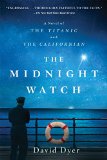Summary | Excerpt | Reading Guide | Reviews | Beyond the book | Read-Alikes | Genres & Themes | Author Bio

A Novel of the Titanic and the Californian
by David DyerDavid Dyer's The Midnight Watch is a powerful and dramatic debut novel - the result of many years of research in Liverpool, London, New York, and Boston, and informed by the author's own experiences as a ship's officer and a lawyer.
As the Titanic and her passengers sank slowly into the Atlantic Ocean after striking an iceberg late in the evening of April 14, 1912, a nearby ship looked on. Second Officer Herbert Stone, in charge of the midnight watch on the SS Californian sitting idly a few miles north, saw the distress rockets that the Titanic fired. He alerted the captain, Stanley Lord, who was sleeping in the chartroom below, but Lord did not come to the bridge. Eight rockets were fired during the dark hours of the midnight watch, and eight rockets were ignored.
The next morning, the Titanic was at the bottom of the sea and more than 1,500 people were dead. When they learned of the extent of the tragedy, Lord and Stone did everything they could to hide their role in the disaster, but pursued by newspapermen, lawyers, and political leaders in America and England, their terrible secret was eventually revealed. The Midnight Watch is a fictional telling of what may have occurred that night on the SS Californian, and the resulting desperation of Officer Stone and Captain Lord in the aftermath of their inaction.
Told not only from the perspective of the SS Californian crew, but also through the eyes of a family of third-class passengers who perished in the disaster, the narrative is drawn together by Steadman, a tenacious Boston journalist who does not rest until the truth is found.
This is an insightful, provocative and well-written novel. I recommend the book to a broad audience, more than just those interested in the Titanic...continued
Full Review
 (507 words)
(507 words)
(Reviewed by First Impressions Reviewers).
Could the tragedy of the RMS Titanic that unfolded on 15 April 1912, have been prevented or the casualty toll severely decreased? This is the question that anchors The Midnight Watch. The SS Californian, which left Liverpool and was headed for Boston with cargo, was in close enough range of the Titanic for some kind of rescue operation to have been carried out but that never happened. The captain of the ship, Stanley Lord, was widely vilified in the press and in congressional hearings but the verdict remains open about exactly could have been done and to what extent.
 Both the Titanic and the Californian were navigating an ice field the day of the tragedy and as it happens, Captain Lord, finding the ship close to a treacherous area, ...
Both the Titanic and the Californian were navigating an ice field the day of the tragedy and as it happens, Captain Lord, finding the ship close to a treacherous area, ...

If you liked The Midnight Watch, try these:

by Naomi J. Williams
Published 2016
By turns elegiac, profound, and comic, Landfalls reinvents the maritime adventure novel for the twenty-first century.

by Greg King, Penny Wilson
Published 2016
On the 100th Anniversary of its sinking, King and Wilson tell the story of the Lusitania's glamorous passengers and the torpedo that ended an era and prompted the US entry into World War I.